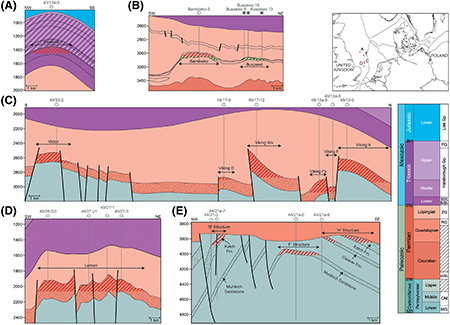The AAPG/Datapages Combined Publications Database
AAPG Bulletin
Figure
AAPG Bulletin; Year: 2023; Issue: August DOI: 10.1306/04042322097
Return to Full Text

Figure 13.
A series of schematic cross sections through key hydrocarbon fields exemplifying the main structural styles and their control on the principal plays in the Anglo-Polish Super Basin (after Lambert, 1991; Brook et al., 2003a, b; Hillier, 2003; Peryt et al., 2010; Besly, 2018). (A) Esmond Field, a typical salt-cored anticline formed by halokinesis of the Zechstein Group; (B) Palaeogeomorphic traps hosting Zechstein Group carbonate reservoirs of the Barnowko and Buszewo fields in Poland; (C) Subsalt structures hosting Rotliegend Group, Leman Sandstone Formation reservoirs of the Viking and Victor fields; (D) The Leman supergiant gas field; (E) Carboniferous plays formed by truncation beneath the Base Permian unconformity and intraformational anticlinal folds resulting from Late Pennsylvanian (Variscan) folding in the Boulton field. Gas accumulations are depicted in red diagonal stripes, oil fields with green diagonal ones. The various subcompartments of the Viking field hosting the Rotliegend, Leman Sandstone reservoir (cross section C) and Boulton field hosting Carboniferous reservoirs (cross section E) are shown with corresponding letters in quotation marks. BSh = Bunter Shale; BSt = Bunter Sandstone; CM = Coal Measures; Fm. = Formation; Gp. = Group; MG = Millstone Grit; PG = Penarth Group; RG = Rotliegend Group; volc. = volcanics; ZG = Zechstein Group.

Figure 13. A series of schematic cross sections through key hydrocarbon fields exemplifying the main structural styles and their control on the principal plays in the Anglo-Polish Super Basin (after Lambert, 1991; Brook et al., 2003a, b; Hillier, 2003; Peryt et al., 2010; Besly, 2018). (A) Esmond Field, a typical salt-cored anticline formed by halokinesis of the Zechstein Group; (B) Palaeogeomorphic traps hosting Zechstein Group carbonate reservoirs of the Barnowko and Buszewo fields in Poland; (C) Subsalt structures hosting Rotliegend Group, Leman Sandstone Formation reservoirs of the Viking and Victor fields; (D) The Leman supergiant gas field; (E) Carboniferous plays formed by truncation beneath the Base Permian unconformity and intraformational anticlinal folds resulting from Late Pennsylvanian (Variscan) folding in the Boulton field. Gas accumulations are depicted in red diagonal stripes, oil fields with green diagonal ones. The various subcompartments of the Viking field hosting the Rotliegend, Leman Sandstone reservoir (cross section C) and Boulton field hosting Carboniferous reservoirs (cross section E) are shown with corresponding letters in quotation marks. BSh = Bunter Shale; BSt = Bunter Sandstone; CM = Coal Measures; Fm. = Formation; Gp. = Group; MG = Millstone Grit; PG = Penarth Group; RG = Rotliegend Group; volc. = volcanics; ZG = Zechstein Group.